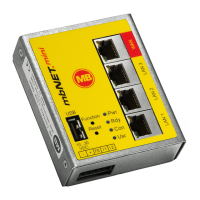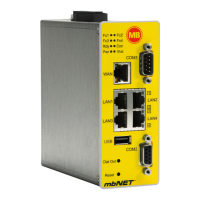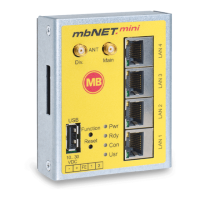Page 44 of 237
Version: 5.1.6 – June 4
th
, 2019
OPEN
At this authentication method, every mobile Station is able to connect with the Access Point if
the SSID matches. Some wireless clients know the option ALL or ANY, which allows to make a
connection with every access point independently of the SSID. Assuming he is configured as
“Open System”.
SHARED
In this authentication, the access point and the mobile station must have the same WPA2 pass-
word. If the entered password does not match with the set password, then the access point de-
nies the authentication of the station. A connection cannot be established if this is the case.
WEPAUTO
The setting is not unique. Depending on the manufacturer or the access point, it may have dif-
ferent impacts. Additionally you have to make specifications about the encryption, the code and
eventually about the encryption strength.
WPAPSK
WPA-PSK is an encryption method that sends data through a pattern which changes the signal
completely. It can only be readed again, if you put the same pattern with the key (Code/Key)
which you can determine by yourself, above it
WPA2PSK
WPA2-PSK is the implementation of a high safety standards in accordance with the WLAN stand-
ards. It is the successor of WPA and one of the safest methods of encryption.
WPANONE
No authentication
AES
The AES decryption requires necessarily that the same steps must be run as at the encryption.
But just in reverse order. It is a weakness of AES.
WEP
Warning! WEP is considered as outdated and is known to be unsafe.
WEP is an encryption method based on a RC4 encryption. For this purpose, a secure key is
stored in each wireless terminal of anyone known and should not be traceable. For this WEP
provides functions for packet encryption and authentication.
TKIP
TKIP uses the same algorithm as WEP. TKIP also ensures, that every data package gets his
own key. Packet who are no fitting into the algorithm, are dropped.
NONE
No Encryption.
Select a WLAN-key and enter it in this field.
Select this setting depending on how many devices and base stations, are sharing the fre-
quency spectrum. You can divide the frequency spectrum of 2.4 GHz with the channel settings.
Channel 1-11 - The channels 1-11 are considered.
Channel 1-13 - The channels 1-13 are considered.
Channel 10,11 - The channels 10 and 11 are considered.
Channel 10-13 - The channels 10 and 13 are considered.
Channel 3-9 - The channels 3-9 are considered.
Channel 5-13 - The channels 5-13 are considered.

